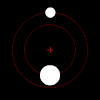Phorcys (moon)
| (65489) Ceto I (Phorcys) | |
|---|---|
| Provisional or systematic name | S / 2006 (65489) 1 |
| Central body | (65489) Ceto |
| Properties of the orbit | |
| Major semi-axis | 1841 ± 48 km |
| Periapsis | 1813 km |
| Apoapsis | 1868 km |
| eccentricity | <0.015 |
| Orbit inclination | 68.8 ± 2.9 ° (Ceto) 116.6 ± 2.9 ° (Phorcys) (equatorial plane) ° |
| Orbital time | 9.554 ± 0.011 d |
| Mean orbital velocity | 0.0070 km / s |
| Physical Properties | |
| Albedo | 0.058 ± 0.03 |
| Apparent brightness | 6.23 ± 0.50 (absolute) mag |
| Medium diameter | 171 ± 10 km |
| Dimensions | 1.67 x 10 18 kg |
| Medium density | 1.37 + 0.66 / -0.32 (system) g / cm 3 |
| Acceleration of gravity on the surface | ≈ 0 m / s 2 |
| Escape speed | ≈ 0 m / s |
| discovery | |
| Explorer |
|
| Date of discovery | April 11, 2006 |
| Remarks | Smaller component of a double asteroid. |
Phorcys is the smaller component ( moon ) of the double asteroid system of the SDO asteroid and centaur (65489) Ceto . Its mean diameter is around 171 kilometers, which is only about 23.3% smaller than the mother asteroid .
Discovery and naming
Phorcys was discovered on April 11, 2006 by Keith Noll, Harold Levison, Will Grundy and Denise Stephens during observations with the Hubble space telescope or recognized as an individual body. Phorcys was found at 0.085 ± 0.002 arc seconds from the ceto discovered three years earlier, with a difference in apparent magnitude of 0.6. The discovery was announced in August 2006; the companion was given the provisional designation S / 2006 (65489) 1 .
On November 23, 2006, together with the Typhon / Echidna and Logos / Zoe systems , the two bodies were officially named by the International Astronomical Union (IAU) after Phorkys , an ancient sea god in Greek mythology , son of Pontus and the Gaia . With his sister, the sea monster Keto , he fathered the Gorgons , the Graiai as well as Echidna and Ladon . He is mainly famous for his monstrous offspring.
Track properties
Phorcys and Ceto orbit each other in an almost circular orbit between 1,813 and 1,868 km distance from the common centers (major orbit half-axis 1841 km or 16.5 ceto or 21.5 Phorcys radii. This results in a mean distance between the two surfaces of about 1644 km if one assumes a round shape of both bodies). Since both revolve around the common center of gravity , the system is to be understood as a double asteroid system - comparable to (79360) Sila - Nunam . The orbital eccentricity of Phorcys is at most 0.015, the orbit is 68.8 ° inclined to the equatorial plane of Ceto .
The orbits of the two bodies around each other are special in several ways. The orbit of Ceto around Phorcys differs significantly from the orbit of Phorcys around Ceto due to an inclination of 116.6 °, the orbits are thereby tilted against each other by 47.8 °. In addition, according to the different angles, the two bodies circle - in relation to Ceto's equatorial plane and direction of rotation - in different directions of rotation: Phorcys prograd and Ceto retrograde around the barycenter. The orbital eccentricity of Ceto, on the other hand, is very likely only insignificantly smaller at 0.0013 at most.
Phorcys and Ceto orbit each other in 9 days, 13 hours and 17.8 minutes, which corresponds to about 38,500 orbits in a Ceto year (1007 earth years). In this binary system, a month therefore lasts 51.76 ceto days.
The Ceto / Phorcys system is perhaps viewed as the second-discovered double centaur system, according to an expanded definition of a centaur as an object with a non-resonant orbit with a perihelion within the orbit of Neptune (which the system passed through in 1989).
Physical Properties
Size / surface
Phorcys has an estimated 171 km in diameter (about 76.7% of the central body) based on the assumed equal reflectivity of 5.8% for Ceto . The surface is therefore extremely dark. The mass fraction of Phorcys in the system is 30.9%. Its diameter had previously been estimated at 132 km.
internal structure
The binary nature of the system has made it possible to calculate the mass of the system directly, with the mass fraction of ceto in the system being 69.1%. This also provided further information on the internal composition of both components. The density of the system was calculated to be relatively low at 1.37 g / cm³. If the system is not porous inside (→ Rubble Piles ), it consists of a mixture of water ice and rock , with a rock content of around 50%.
It has been hypothesized that tidal forces , along with other potential heat sources (for example, collisions or 26 Al - radiation ) may have sufficiently increased the temperature to amorphous ice to crystallize and to fill the voids in the two bodies. The same tidal forces could be responsible for the quasi-circular orbits of the two components.
exploration
Since its discovery in 2006, Phorcys could be observed through a combination of the Hubble and Spitzer space telescope as well as through terrestrial telescopes, and its size and orbital elements could be determined.
See also
Web links
- Wm. Robert Johnston: (65489) Ceto and Phorcys
- Will M. Grundy et al. : The orbit, mass, size, albedo, and density of (65489) Ceto / Phorcys study from 2007 on Ceto and Phorcys including recordings (PDF, English)
- International Astronomical Union Circular No. 8778 November 23, 2006 (discovery and naming)
